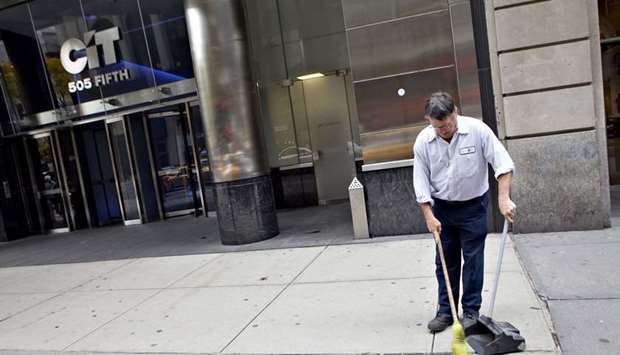Executives at regional US banks often say they’re only going to do as well as their clients. That’s now more true than ever.
Investors are focused on which firms are exposed to the wrong industries as the coronavirus pandemic roils the economy, and they plan to scour for clues as the lenders report results in coming weeks. Bank stocks have plunged as the duration and severity of the crisis remain uncertain. The KBW Regional Banking Index tumbled 41% during the first three months of the year, the worst quarter in its history of more than two decades.
Much of the differentiation between the regional lenders will come from their individual exposure to the hardest-hit sectors and geographies in what economists predict will be the most severe quarterly contraction on record.
“Spoiler alert: Our question for the first-quarter earnings calls is, ‘What is your exposure to airlines, hotels, tourists and other industries exposed to the coronavirus?’” Mike Mayo, a Wells Fargo & Co analyst, said in an interview.
With hundreds of millions of Americans advised to stay home, it’s not surprising that travel bookings and restaurant visits have plummeted. An unprecedented surge in jobless claims – a record 6.65mn for the week ended March 28 – spells trouble for banks with exposure to a variety of consumer and commercial loans. Ally Financial Inc, the biggest US auto lender, is a prime example. Its stock lost more than half of its value in the first quarter.
Analysts and investors say regional and even more specialised banks like Detroit-based Ally have stronger capital buffers than they did going into the 2008 financial crisis, which will help them survive if credit losses mount. But the firms were already seeing profits pinched by low interest rates and rising technology costs as they sought to compete with bigger banks and upstarts.
Then there’s CIT Group Inc, the lender that went bust in the wake of the last crisis, failing to repay a $2.3bn taxpayer bailout. John Thain, the former Merrill Lynch chief, took over in 2010 as CIT emerged from bankruptcy and honed its focus on US commercial lending. By the time he announced his departure in 2015, Thain had overhauled the company’s financing, rebuilt relations with regulators and completed a $3.4bn acquisition of OneWest Bank.
The rebuilding effort continued under his successor, Ellen Alemany, who oversaw steady stock-price and dividend increases. Now, a decade after its rebirth, the company is watching its stock tumble again.
Shares of Livingston, New Jersey-based CIT plunged 62% in the first quarter, the worst performance in the 24-company KBW Bank Index. Real estate, manufacturing and retail comprise almost 40% of its lending portfolio. Each of those sectors has been hit hard by the coronavirus, and there’s more pain to come.
Still, CIT notes that most of its commercial banking portfolio is focused on collateral-based lending and leasing. And in a sign of confidence, executives and board members have purchased a combined $1.67mn of stock in the past month, regulatory filings show.
The pandemic, coupled with an unrelenting price war between Russia and Saudi Arabia, has dealt a crushing blow to the oil and gas industry. Oil posted its worst quarter on record as a result of that double-whammy, with prices falling below $10 a barrel across major shale regions in Texas and North Dakota. That may prove particularly onerous for lenders with exposure to US exploration and production companies.
On Wednesday, Whiting Petroleum Corp filed for bankruptcy, less than five years after Canaccord Genuity hailed the Denver-based explorer and producer as one of the “comeback kids” of US shale.
“You’re going to have energy losses and you’re going to have a lot of stress,” KBW analyst Brady Gailey said in an interview.
Cadence BanCorp and Texas Capital Bancshares Inc tumbled more than 60% this year, the two worst performers among 50 firms in the KBW index of regional lenders. Energy lending made up 11% of Cadence’s loan portfolio as of year-end. At Texas Capital, 22% of total loans were related to real estate and construction, and 6.7% for oil and gas pipelines.
“It’s stressful but manageable,” Cadence chief executive officer Paul Murphy said in a phone interview. “Every credit we renew, we’re doing a Covid impact assessment to see how they’re going to get through it.”
Exploration and production is just 3% of the loan portfolio, he noted.
The challenges will also play out at different times for different banks based on their geographical location, given that the virus isn’t spreading at the same rate across the country, said Don J Musso, the CEO of FinPro Inc., a consulting firm focused on community banks.
“It ultimately comes down to the quality of underwriting,” Mayo said. “How well does a company originate loans? What sort of credit culture do they have? And have they maintained that conservatism during a period of several good years?”
Investors hoping the first day of the second quarter would bring relief learned they’d have to wait. The KBW Regional Banking Index tumbled an additional 5.4% on Wednesday.
The magnitude of the challenges facing the banks will largely be defined how long commerce is shut down.
“It’s tough to know exactly how this is going to play out,” Gailey said. “Before, it was about loan losses and stuff you felt like you could get your hands around. This time it’s an unknown.”

A building maintenance worker sweeps the sidewalk outside the former CIT Group Inc headquarters in New York (file).


